The Latest Dirt - March 2023
Plant California Fuchsias Now for Hummers, Bees, and Fall Color
By Robin Mitchell
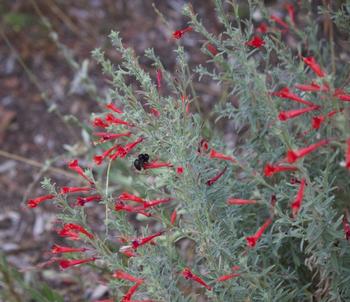
There are so many reasons to love California fuchsias! They are drought tolerant, fast-growing, small to mid-size perennials that deer generally find unpalatable. They are easy to grow, and they tolerate garden conditions well. They bloom in late summer and into the fall when most other natives have stopped blooming or gone dormant. Hummingbirds and bees love the profuse red-orange funnel-shaped flowers, and the fuzzy silver or green foliage adds lovely color and texture to your garden.
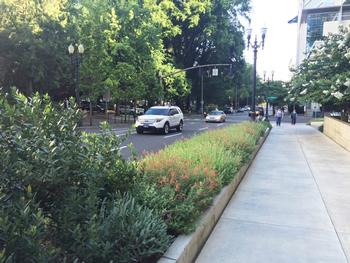
California fuchsias (Epilobium canum and related subspecies and cultivars) like full sun in most areas, although they appreciate a little shade where it’s very hot. They can make it through the summer with no supplemental water in cooler areas, but in hot settings they need occasional summer watering, and they appreciate a few monthly soaks in late summer and fall almost anywhere. Most tolerate clay and sandy soils. My garden is typical East Bay clay, and these plants do well. They spread by rhizomes as well as from seed in certain conditions, although I don’t think they have reseeded in my garden. I have not found them to be overly aggressive, and I am happy they are slowly spreading out from where I originally planted them. It is also fairly easy to start new plants by cuttings, which I have done several times to give to friends.
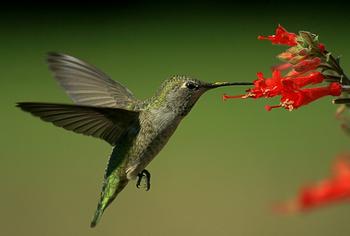
There are two closely related species of native “fuchsia” in California: the silvery, compact Humboldt County fuchsia (Epilobium septentrionale), endemic to the North Coast and the Outer North Coast Ranges, and the much more widespread California fuchsia (Epilobium canum). The range map for E. canum in the Calflora native plant database shows it growing abundantly in coastal areas of Southern and Central California as well as in the Sierra Nevada, and it also grows in several other western states as well as northwestern Mexico. There are many different forms of E. canum, including three subspecies and many nursery cultivars, each with a different combination of plant size and shape, flower size and color, and leaf size and color. There are even cultivars with white, coral, or pink flowers.
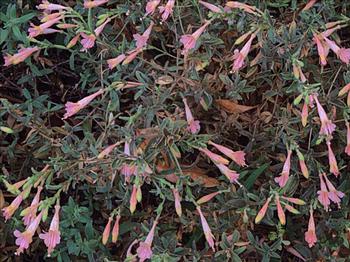
I have two different kinds of California fuchsia in my El Cerrito garden. One is a lower-growing plant (about one foot to 18 inches high including flowering stalks), which I use as a ground cover next to the public sidewalk. It might be the ‘Calistoga’ cultivar, although at this point I am not sure. The other has a very different growth habit, with taller foliage and three-foot spikes of flowers. I purchased both from local nurseries many years ago, and they are still going strong. Neither location receives any summer water, although we did water them a few times last fall because the rains were so late.
In mid- to late summer (generally August, although sometimes July) the California fuchsias in my yard start to bloom, and this past year there were still blooms left in November because of our mild fall. The red tube-shaped flowers are very attractive to hummingbirds and are a welcome source of nectar in the fall for our local Anna’s hummingbirds. Allen’s hummingbirds breed on the coasts of southern Oregon and much of California and migrate south to Mexico in mid- to late summer. You might have one visit your fuchsia if its bloom timing coincides with the Allen’s breeding period in the Bay Area or their southward migration (July and early August).

Bees are also attracted to the California fuchsia. I have seen carpenter bees, which are too large to get into the tubular flower, puncture the flower at its base and drink nectar through the hole. This nectar-robbing doesn’t pollinate the flower but does provide needed food for the bees.
California fuchsias tend to die back and go somewhat dormant in the winter, and it is important to prune them back in the early winter to keep them healthy and robust. By late last fall (October), the low-growing variety in my garden had become leggy and was sprawling out onto the sidewalk. So in December, we cut it back to within a few inches of the ground. Now, in late February, the new growth is starting to appear, and I think it will come back “rejuvenated” and “lush and healthy” as several sources indicate when describing the effects of early winter pruning.
My favorite source for information about gardening with native plants is California Native Plants for the Garden by Carol Bornstein, David Fross, and Bart O’Brien (currently out of print, but available in libraries). The book has a lengthy discussion of California fuchsia (under its former genus name Zauschneria), mostly talking about the large number of cultivars that are available, with lots of wonderful photos.
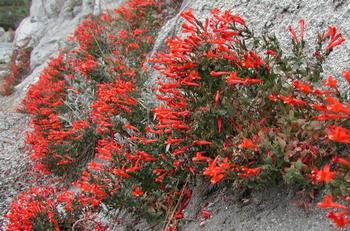
Our CNPS East Bay Chapter’s Native Here Nursery has the “straight species” (E. canum ssp. canum) which grows two to three feet high and is noted to need well-drained soil, although Calscape indicates the straight species will tolerate both clay and sand. Other nurseries should have cultivars that will tolerate the classic East Bay flatlands clay soil. Annie’s Annuals sells E. canum and says it tolerates “clay-ish soil.” And as I indicated earlier, I have clay soil and have not had problems growing the plants I purchased from nurseries.
So plant a California fuchsia, and you will make some hummingbirds very happy this coming fall!
This article was originally published in the March 2021 Bay Leaf newsletter of the California Native Plant Society East Bay Chapter.
